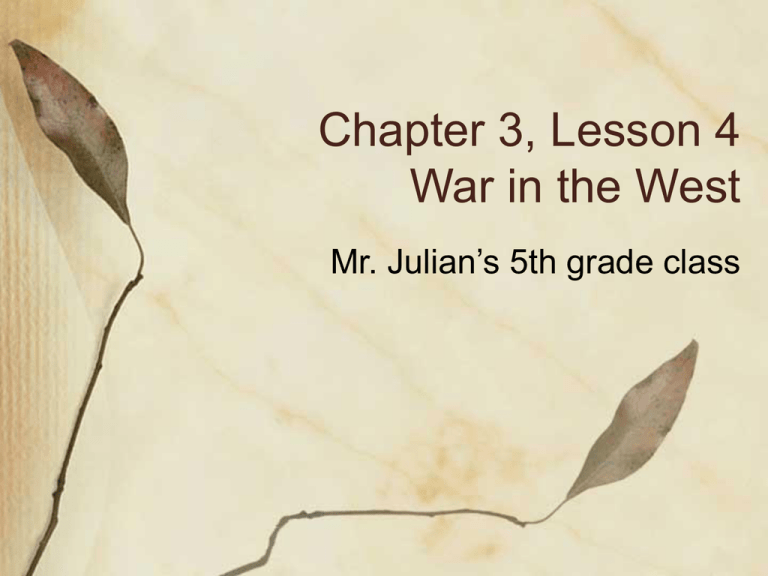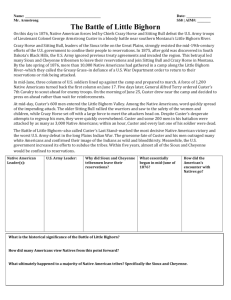Chapter 3, Lesson 4 War in the West
advertisement

Chapter 3, Lesson 4 War in the West Mr. Julian’s 5th grade class Essential Question What changes threatened the traditional way of life for the Native Americans? Place of Importance Black Hills People of Importance Sitting Bull George Custer Crazy Horse Chief Joseph Geronimo Vocabulary Reservation Battle of Little Bighorn Conflict on the Plains As more pioneers moved west this led to conflict with the Native American people already living there. They felt that their traditional way of life was being threatened. Conflict on the Plains The U.S. government was determined to support the new settlers. At first the government offered the Native Americans money and goods. The Native Americans did not value those things. Conflict on the Plains The next step the government tried was to send the Native Americans to reservations, an area of land set aside for Native Americans. The government used military force to make sure the Native Americans in fact moved. Conflict on the Plains Most Native American tribes realized that they were not powerful enough to defeat the U.S. Army so they left their land for the reservations. In 1868, the Lotoka signed a treaty that gave them the land in the Black Hills region of South Dakota and Wyoming. Conflict on the Plains In 1874, gold was found in the Black Hills. The government asked the Lokota to move again. Sitting Bull refused to sell his land. The Battle of Little Bighorn The U.S. sent the 7th Cavalry, led by Col. George Custer, to defeat the Lakota. Sitting Bull and the Lakota were camped along the river Little Bighorn. Crazy Horse, one of the most successful warriors, was also in the camp. The Battle of Little Bighorn Custer found the Lakota on June 25. Custer was badly outnumbered but he decided to attack anyway. Crazy Horse led the Lakota’s to a victory at the Battle of Little Bighorn. The Battle of Little Bighorn This battle is known as “Custer’s Last Stand” as he was killed along with his entire unit of 200 soldiers. Little Bighorn will be remembered for two reasons: 1. It was the biggest victory Native Americas won over the U.S. The Battle of Little Bighorn The second reason was it led to the end of all Native American’s freedom The loss led the government to take stronger measures to defeat the Native Americans By the end of 1877, Crazy Horse and the Lakota were forced into reservations. Sitting Bull escaped to Canada Chief Joseph The tribe of the Nez Perce lived in Oregon. The government decided the Nez Perce should of move to a reservation in Idaho. The Nez Perce, led by Chief Joseph, decided to flee to Canada. Chief Joseph The U.S. Army chased the Nez Perce during the entire 1,600 mile journey. Running low on food and supplies the U.S. Army surrounded the Nez Perce, just 40 miles from Canada. Chief Joseph surrendered, telling the army that he was tired of fighting… After the Wars The last tribe to fight for their freedom was the Apache, led by Geronimo. Geronimo led a group of warriors into the mountains in Mexico. Geronimo was finally captured in 1886 saying “Once I moved like the wind. Now I surrender to you and that is all.” After the Wars The last major conflict between the U.S. and the Native Americans took place in 1890. A group of Lakota decided to leave the reservation and were captured at Wounded Knee, South Dakota. After the Wars While most families were turning over their weapons, a shot was fired. The U.S. Army began to return fire, killing about 300 Lakota. This marked the end of the wars between the U.S. and the Native Americans. After the Wars Today, Native Americans have won court cases giving them control of their reservations. Both on and off the reservations, Native Americans have kept their traditions alive. Young people are learning their native language. Today, film makers continue to tell stories about Native American’s way of life. Review Questions What changes threatened the way of life for Native Americans? Why was the Battle of Little Bighorn important?











